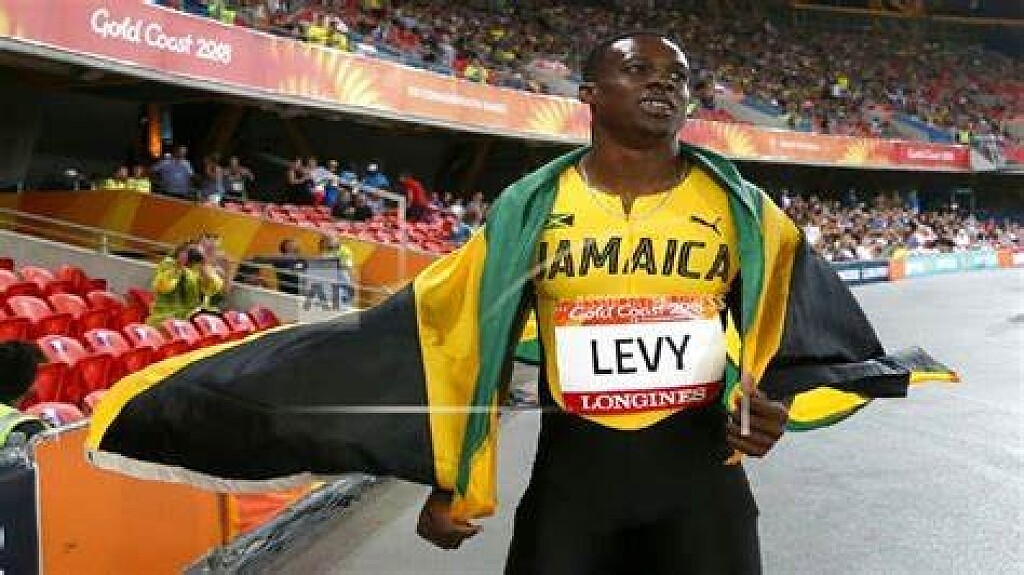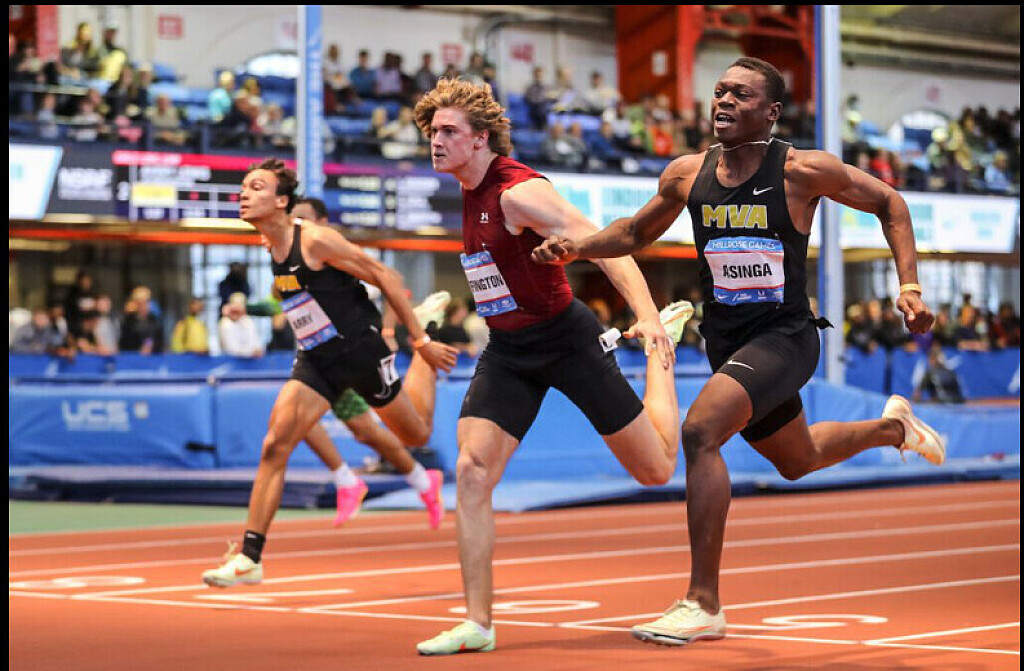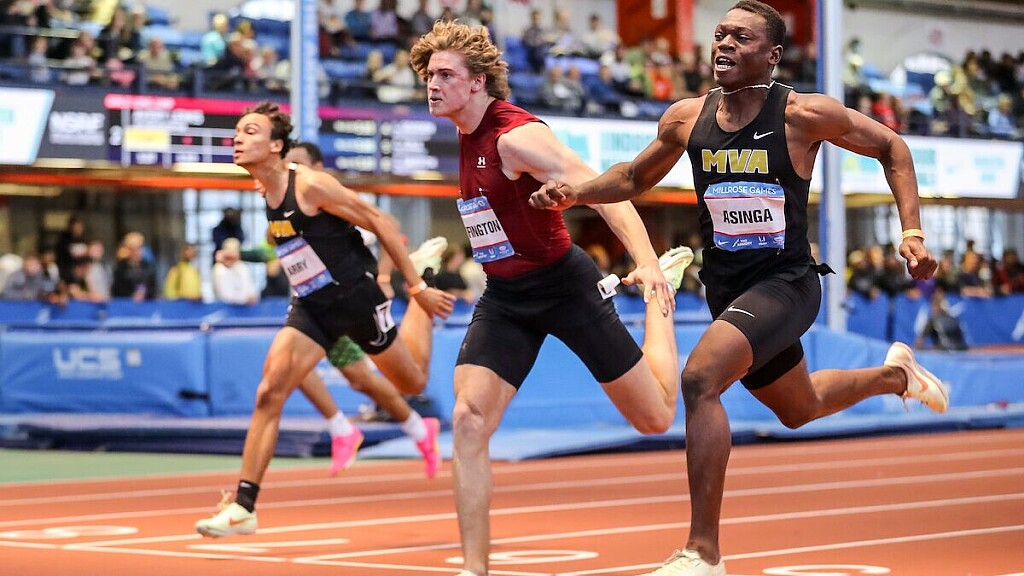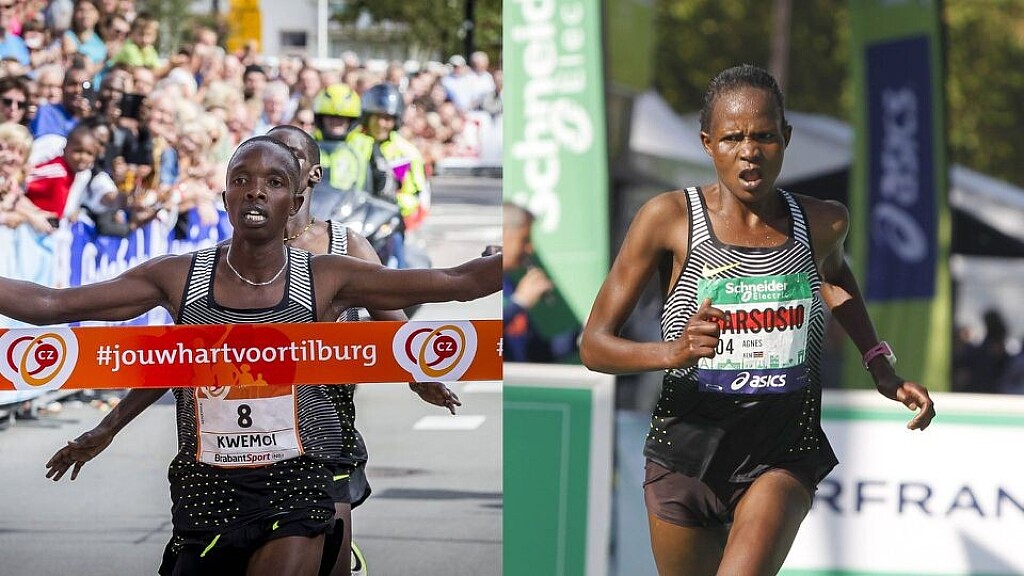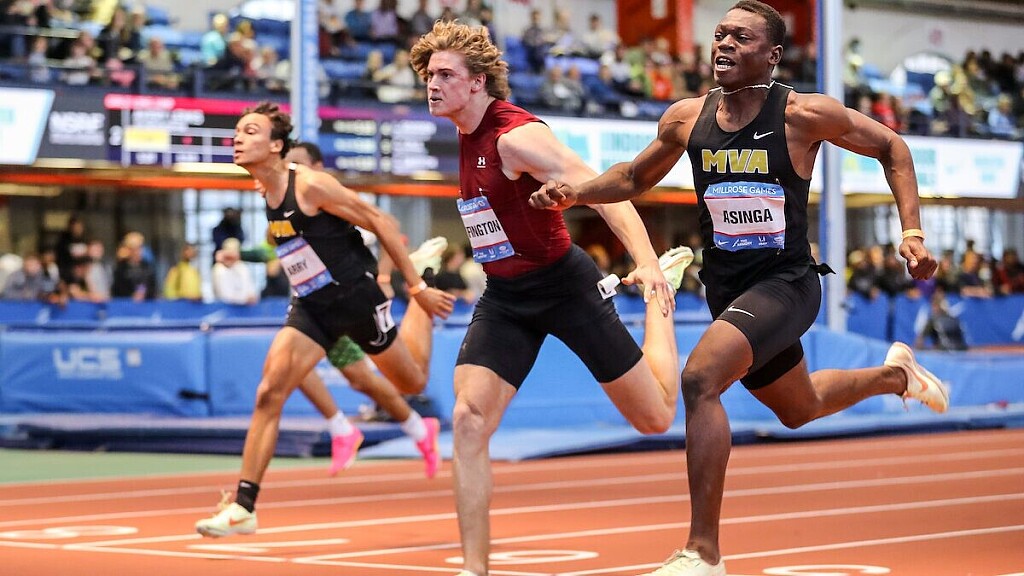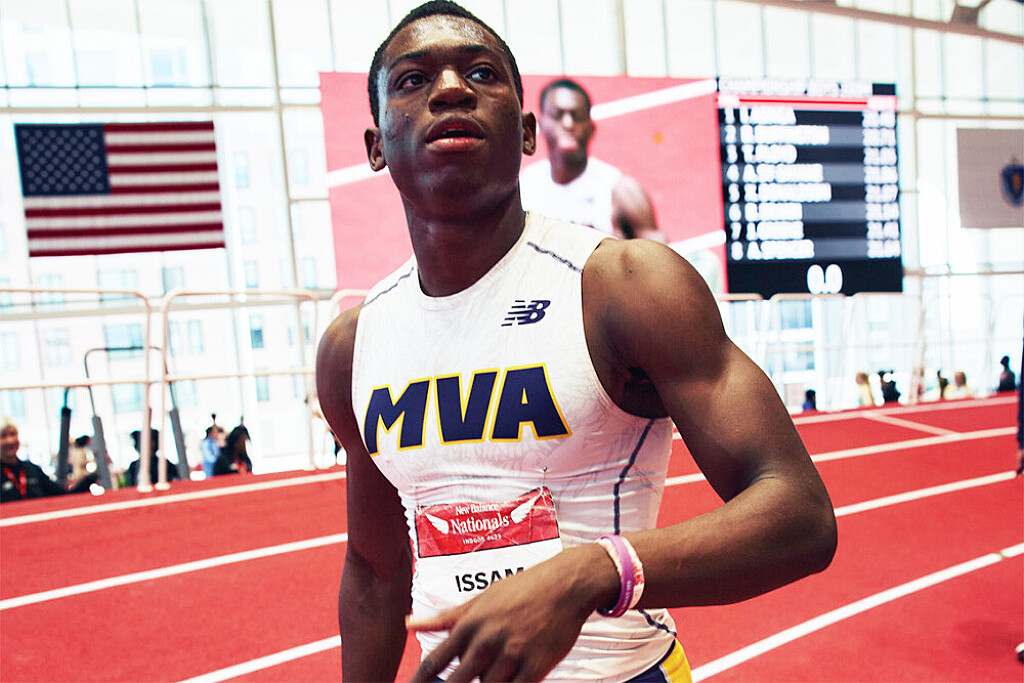Running News Daily
Running News Daily is edited by Bob Anderson. Send your news items to bob@mybestruns.com Advertising opportunities available. Train the Kenyan Way at KATA Kenya and Portugal owned and operated by Bob Anderson. Be sure to catch our movie A Long Run the movie KATA Running Camps and KATA Potato Farms - 31 now open in Kenya! https://kata.ke/
Index to Daily Posts · Sign Up For Updates · Run The World Feed
Articles tagged #Issam Asinga
Today's Running News
Jamaican Olympic medalist given four-year doping ban
The Tokyo 2020 Olympic 110m hurdles bronze medalist, Ronald Levy of Jamaica, was dealt a four-year ban after an out-of-competition test for GW1516.
On Friday, Ronald Levy, the Tokyo Olympic 110m hurdles bronze medalist from Jamaica, was handed a four-year ban by the Jamaica Anti-Doping Commission (JADCO) following a positive test for banned substances.

The substance detected in Levy’s sample, taken during an out-of-competition test in October 2023, was GW1516. This black-market drug is known for enhancing endurance and increasing the body’s ability to burn fat, allowing users to train harder and longer. However, GW1516 has not been approved for human use due to concerns about its potential cancer risks and other severe long-term health effects.
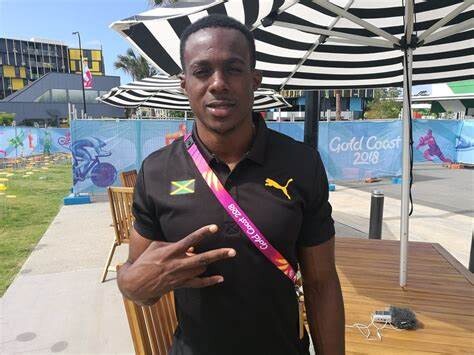
Levy said on social media that he was shocked at the positive test result, maintaining he did not knowingly violate any rules: “I am stunned by this turn of events because I have always conducted myself with the highest level of integrity in the sport, which I love dearly, and would never seek to gain an unfair advantage.”
The 31-year-old hurdler won bronze at the Tokyo 2020 Olympics behind American Grant Holloway and Levy’s fellow Jamaican, Hansle Parchment. He also won gold in the 110m hurdles at the 2018 Commonwealth Games. Levy has not competed since September 2023 and did not qualify for the 2024 Paris Olympics.
Levy has the right to appeal the decision and take his case to the Court of Arbitration for Sport (CAS). While a successful appeal could overturn the ban, the process could also result in significant financial and physical strain if the appeal is unsuccessful. This is the third high-profile GW1516 case in the past two years, following the positive tests of former Olympic 800m silver medalist Nijel Amos of Botswana and Surinamese sprinter Issam Asinga, the U20 100m record holder. Both men tested positive during out-of-competition tests.
by Marley Dickinson
Login to leave a comment
Teen sprinter sues Gatorade over doping ban that cost him an Olympic spot
The fastest high school sprinter in history is suing Gatorade, claiming the company gave him a fraudulently certified product that contained a banned substance and led to his four-year banishment from track and field, costing him a chance to compete in the Paris Olympics.
Issam Asinga, the Surinamese teenager who set the under-20 world record in the 100 meters, said that when Gatorade honored him as its high school track and field athlete of the year in July 2023, it provided a gift basket that included Gatorade Recovery Gummies. In a lawsuit filed Wednesday, the 19-year-old Asinga claims those gummies are the reason he later tested positive for the banned substance GW1516, which led to a four-year ban this May and stripped him of his record. The suit further claims the company took measures to protect its reputation, damaging Asinga’s in the process.
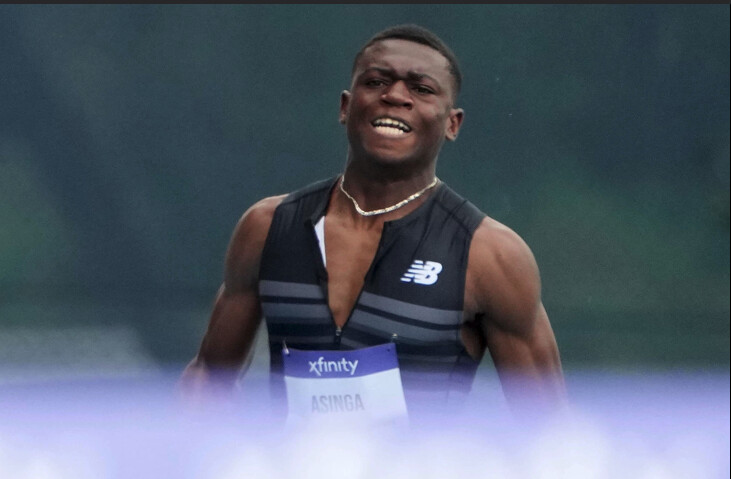
Asinga filed suit in the Southern District of New York against Gatorade and Pepsi Co., its parent company. He is seeking, according to the lawsuit, to “recoup the millions of dollars he has lost in economic opportunities, as well as compensation for the devastating emotional harm he has suffered.”
In an emailed statement, a Gatorade spokesperson said: “The product in question is completely safe and the claims made are false. … Gatorade products are FDA compliant and safe for athlete consumption, which was validated by the findings of the Athletics Integrity Unit investigation.”
Were he eligible, Asinga could have competed for Suriname at the Paris Olympics, earning potentially millions on a sponsorship deal. Instead, he is banned from the Games and lost his endorsement opportunity. The suspension also will prohibit him from training with or competing his college teammates at Texas A&M, and despite support from his coaches, Asinga believes he could lose his scholarship.
“You’re either guilty or you’re not,” Asinga said in a Zoom interview alongside his lawyers. “I know I’m not, so I’ve got to chase my dream. I’ve got two Olympian parents; I was born to run. Am I going to destroy my dream because of something I didn’t do, or am I going to keep fighting until the end?”
‘I was honored when they told me to get tested’
Asinga grew up in Atlanta, went to a St. Louis boarding school, lived a couple of years in his mother’s native Zambia, went to high school in Florida and currently attends Texas A&M. He is the son of track and field Olympians: His mother, Ngozi, competed for Zambia, and his father, Tommy, once served as the flag bearer for Suriname.
By the summer of 2023, Asinga had become one of the world’s most promising track athletes. That April, he stunned the track world by beating world champion Noah Lyles in a 100-meter race in Florida with a wind-aided time of 9.83 seconds.
Asinga chose to compete under the flag of Suriname. In a Zoom interview Wednesday, as he described the effect of his son’s suspension on his home country, Tommy began to cry.
“I felt like I had more of an opportunity to make a difference running for Suriname,” Issam Asinga said. “In Suriname, the one thing that’s holding them back is the facilities. They don’t have someone who can make that difference. I can use whatever I do in my track career to help better this country.”
Gatorade named him its 2023 Florida boys’ track and field player of the year and invited him to a July 11 ceremony in Los Angeles. One month before the ceremony, according to the lawsuit, Asinga took a drug test that came back clean.
“I was honored when they told me to get tested,” Asinga said. “I was like, ‘Okay, bet!’ That’s how I know I’m going somewhere.”
At a gathering the day before the awards ceremony, Gatorade gave Asinga and other athletes a gift bag that included cherry-flavored Gatorade Recovery Gummies. The container was stamped as “NSF Certified for Sport.” NSF is an independent public health organization.
According to the lawsuit, Asinga’s mother texted Issam’s coach, Gerald Phiri, a photo of the ingredient label and asked, “Is this ok to eat[?]”
When Ngozi showed him a picture of the Gatorade logo, Phiri wrote back: “Oh yea these are both fine. Gatorade doesn’t make products that are against sporting rules.”
For the next two weeks, according to the lawsuit, Asinga took two gummies after his workouts. The Athletics Integrity Unit (AIU), the drug-testing arm of World Athletics, tested him again July 18.
Asinga stopped taking the gummies “on or around” July 25, according to the lawsuit. On July 28, Asinga ran the 100 meters in 9.89 seconds at a meet in São Paulo, Brazil. This time, the wind was legal: He had broken the under-20 world record. The AIU tested him again on that day, and that July 28 test would come back clean.
On Aug. 9, 2023, the AIU informed Asinga he had failed the July 18 drug test. Picograms of GW1516 had been detected in his urine. When Asinga received the call, he said, he dropped to his knees in shock.
“It was devastating,” Asinga said. “It was the worst day of my life.”
Known as cardarine, GW1516 was originally developed as a potential treatment for obesity and alters how the body metabolizes fat, according the U.S. Anti-Doping Agency. It is illegal for use in food or medication. The U.S. Anti-Doping Agency notes in its handbook, “athletes should be aware, however, that dietary supplements may be contaminated with this compound.”
Asinga and his lawyer, Paul Greene, who specializes in defending athletes accused of performance-enhancing drug use, compiled a list of foods and supplements he had consumed that could be tested for GW1516. They included the Gatorade gummies.
“We kind of laughed it off,” Asinga said. “It was the last thing I would have thought this source would have been in. This brand is something I’ve looked up to my whole life. Gatorade is a part of sports.”
Asinga sent the gummies to the same lab, according to the lawsuit. On Oct. 26, 2023, according to the lawsuit, the lab notified the AIU that “preliminary findings” concluded the Gatorade gummies had been contaminated with GW1516.
When a company produces a dietary supplement that requires certification, it makes them in numbered lots so each lot can be tracked in case of contamination. By federal regulation, it must keep samples of each lot.
According to the lawsuit, further testing at the Utah lab confirmed not only the GW1516 contamination in the gummies Asinga had supplied; it also showed the same baseline concentration of GW1516 that had been detected in Asinga’s drug test. The chemical codes matched. The lab provided those analytical results to the AIU.
According to the AIU decision, the lab noted “two unusual aspects.” There was a “large discrepancy in the findings between the two containers of the Gatorade Recovery Gummies” and the contamination was present on the surface of the gummy rather than uniformly distributed.
The lab concluded “it was not possible to rule out deliberate adulteration of the product after it was opened,” the decision read.
Asinga’s lawyers said it defies belief that Asinga could have adulterated the gummies.
“All of them would have had to have been dipped individually in a formula that would have been watered to a trillionth of a gram,” Greene said. “An 18-year-old kid living in a dorm would have had to have done that. It’s almost laughable that that’s what he was accused of doing.”
According to the lawsuit, Asinga again contacted Gatorade and requested a sealed bottle from the 22092117150234 lot.
According to the lawsuit, Gatorade instead sent a bottle of recovery gummies to the AIU from a different lot. That lot had been tested by NSF and was accurately labeled as such, according to the lawsuit. The NSF, in a a public notice issued in early June, said the container in Asinga’s case came from an allotment it had not tested.
“They did a bait-and-switch,” said Alexis Chardon, the lawyer representing Asinga in court. “They said, ‘We don’t have a sealed supplement of the one we gave Issam. But we have this other one. Why don’t you take this one?’ That one was NSF tested. And then they let that lie fester.”
“Gatorade fully complied with the Athletics Integrity Unit investigation, including producing evidence that was accepted by the AIU that the gummies were not contaminated with the banned substance in their original ruling,” a Gatorade spokesperson said in an emailed statement.
When the AIU tested the gummies from that container, the results came back clean, according to the lawsuit. Once the AIU received those tests, it handed down its four-year ban to Asinga.
“Gatorade created, fed, and encouraged the false narrative that Issam was given ‘clean’ gummies and therefore Issam had adulterated the ones he got tested,” the lawsuit reads.
Attempting to restore a reputation
On June 14, less than two weeks after the NSF released its public notice about Gatorade, Asinga received what he hoped would be a breakthrough: A representative from the AIU called Greene and told him Gatorade had found and sent a sealed bottle from the same lot as Asinga’s bottle of recovery gummies. If that bottle was tainted with GW1516, it would be pivotal to overturning Asinga’s suspension.
The tests came back negative, according to the lawsuit.
Feeling “confused,” according to the lawsuit, Asinga contacted other athletes from the 2023 awards ceremony and found one who had a similar bottle of recovery gummies. When that bottle was tested for GW1516, according to the lawsuit, it also came back negative.
“For a while, it looked like we dug ourselves in deeper,” Chardon said.
According to the lawsuit, Asinga’s team had one more idea: On June 26, they asked for his original recovery gummies to be retested. They wondered whether the GW1516 had become undetectable over the previous six months.
On July 5, according to the lawsuit, the results came back: The gummies that once had tested positive now returned a negative result.
“Gatorade’s delay had cost Issam the possibility of proving contamination in a sealed container from the same lot he had ingested, robbing him of the possibility of ever meeting the AIU’s gold standard test for showing innocent ingestion of a banned substance,” the lawsuit reads.
In a statement, Gatorade said it “spent those months looking for the specific lot number in the field and, once sourced, immediately provided the product to the AIU.”
Because GW1516 is illegal, Greene said, scant testing has been done on it. Greene is hoping to organize lab tests that can prove GW1516 could become undetectable over the six months. He hopes to use that finding in his Court of Arbitration for Sport appeal later this year.
The lawsuit against Gatorade made Wednesday “one of the first days I can say I’m actually taking a deep breath and let it out a little bit,” Ngozi said. “As a parent, it’s so overwhelming. You never in a million years expect your child to be fighting for his character and his integrity because of something he didn’t do.”
Over the past month, Asinga lost his final glimmer of hope that he could run in the Paris Olympics. He has remained optimistic that he will sprint next year for Texas A&M. He has cried and felt depressed at times. Over the winter, he stopped practicing for several days and wondered whether track was worth it. He still believes he will prevail.
“It hurts,” Asinga said. “There’s been some bad days. The clouds might be over us. But they’re going to have to clear eventually.”
Login to leave a comment
The Issam Asinga Case: Evil Coverup or Did The Fastest High School Sprinter Ever Test Positive For Drugs After Eating Gatorade Gummies?
Six weeks ago, 19-year-old Issam Asinga, the fastest teen sprinter in world history, was handed a four-year ban from the sport of track & field after testing positive for the banned substance GW1516. Asinga’s positive sample came in July 2023, just days before he ran 9.89 seconds to become, at the time, the youngest person in history to break 10 seconds for 100 meters. Asinga, who had been provisionally suspended since August 2023 by the Athletics Integrity Unit (AIU), appealed the decision to the AIU’s disciplinary tribunal, who ruled against him and upheld the four-year suspension on May 27.
Until then, the details of Asinga’s case had been kept secret. Now they are public, and potentially explosive.
Asinga, who maintains his innocence, blamed the positive test on contaminated Gatorade gummies he received at the company’s National Athlete of the Year ceremony in Los Angeles last summer, where he was honored as high school track & field athlete of the year. Asinga has already appealed his case to the Court of Arbitration for Sport, where it is expected to be heard later this year. He is also mulling whether to launch a civil suit against Gatorade because the gummies in question falsely carried an NSF Certified for Sport label, which signified that the product did not contain any prohibited substances. NSF has made a public statement saying the gummies from Asinga’s lot number were not NSF Certified and the NSF Certified mark was being used without authorization.
“They distributed a supplement that wasn’t NSF Certified for Sport that had a banned substance in it,” said Asinga’s lawyer Paul Greene. “That’s violation of product liability law, negligence, implied warranty, New York state consumer protection law. I mean, it’s bad. He had the possibility of getting endorsement and NIL deals that were going to be in the millions of dollars and he lost all that as a result of this. He also lost out on the chance to compete in the World Championships and the Olympics.”
The AIU, however, was not satisfied that the gummies were the source of Asinga’s positive test, and its disciplinary tribunal agreed.
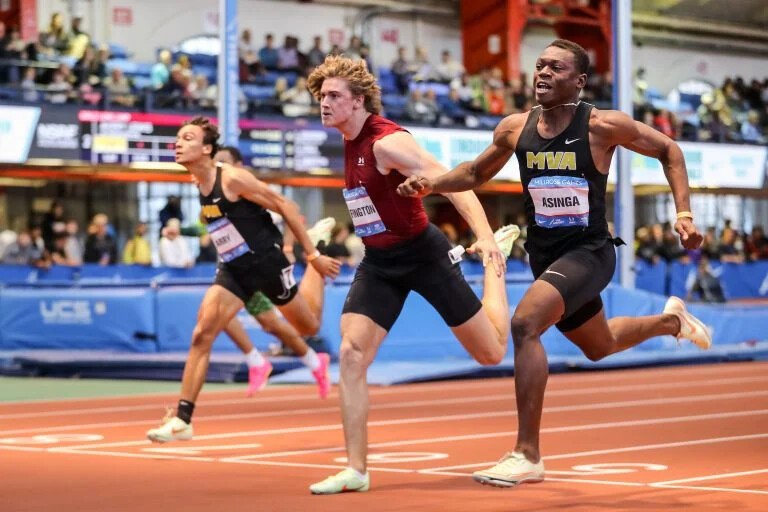
Incredible 2023 high school season
Asinga’s is one of the highest-profile doping cases in recent years. After running personal bests of 10.44 seconds in the 100m and 20.76 in the 200m as a junior in 2022 at Principia High School in Missouri, Asinga transferred to Montverde Academy in Florida for his senior year, where he improved enormously and produced one of the greatest seasons ever by a high school sprinter.
During the 2023 indoor season, Asinga won national high school titles in the 60m (6.59) and 200m (20.48) at New Balance Nationals, tying the national record in the former event (he ran 6.57 in the semis) and breaking the national record in the latter. Outdoors, Asinga ran a wind-aided 9.83 in the 100m to defeat Noah Lyles, who would go on to win the world title in that event four months later. Asinga, who was born in the US but represents Suriname internationally, then ran 19.97 in the 200m in April (#2 all-time among US high schoolers) and 9.89 in July to win the South American 100m title in Sao Paulo, Brazil. The latter time ranked Asinga in a tie for ninth in the world in 2023. It was also a world U20 record and was the first time a US high school athlete had broken the fabled 10-second barrier.
Now that world U20 record has been stripped as Asinga finds him at the center of controversy. The 43-page decision in his case released by the AIU presents only two possible versions of events.
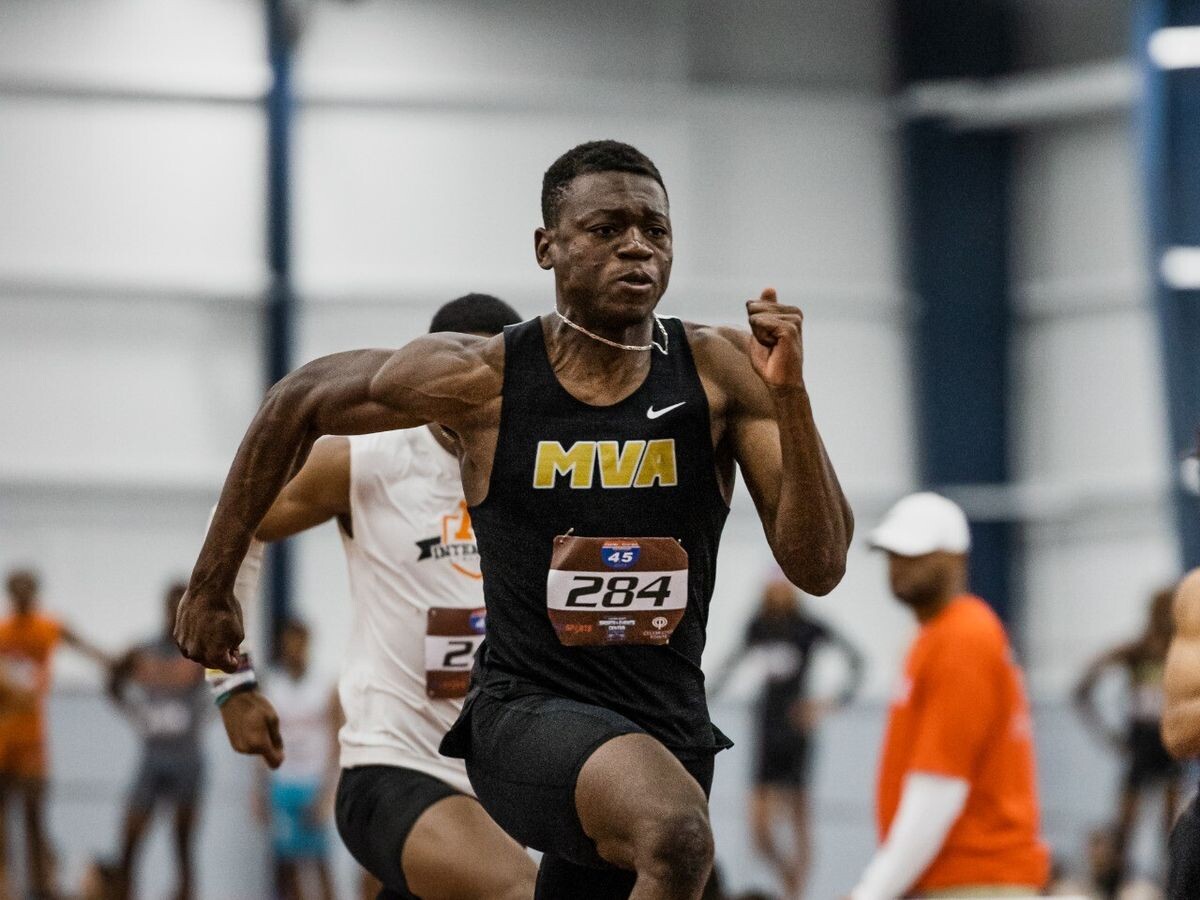
Option A: An 18-year-old was caught doping barely a month after being added to the international testing pool. Then he or someone in his camp tried to cover up his doping by manipulating evidence and defaming Gatorade, one of the world’s largest sports nutrition companies.
Option B: One of the greatest sprint talents in history was unjustly banned after consuming a tainted supplement given to him by one of the most famous brands in sports.
Neither picture is particularly rosy for the sport of track & field, but one of them must be true. After reviewing the evidence, the AIU and its disciplinary tribunal is clear which version it believes: Option A. As a result, Asinga is banned from competition until 2027 barring a successful appeal to CAS.
Background: Asinga enters the testing pool
Most high school track athletes, even elite ones, are rarely drug-tested. But by the spring of 2023, Asinga was running so fast it was becoming clear he could be a factor at that summer’s World Championships in Budapest. He was added to the World Athletics Testing Pool on June 1.
Asinga was tested on June 11 and returned a negative result. He was tested again out-of-competition on July 18 (in his training base of Clermont, Fla.) and again at the South American championships on July 28. The July 18 sample tested positive for GW1516, a banned substance that modifies how the body metabolizes fat and has been found to cause cancer. Specifically, Asinga’s sample tested positive for low levels of two metabolites of GW1516 — a metabolite is a substance produced when the body breaks down a specific drug. In this case, Asinga’s urine contained the GW1516 sulfone metabolite (at a concentration of 0.2 nanograms per milliliter in both his A sample and B sample) and the GW1516 sulfoxide metabolite (at a concentration of 0.5 ng/mL in his A sample and 0.4 ng/mL in his B sample).
On August 9, Asinga was informed of his positive test and provisionally suspended from competition. Shortly after, in an effort to prove his innocence, he began sending his supplements to be tested for contamination at the Sports Medicine Research and Testing Laboratory (SMRTL), a WADA-accredited lab in Salt Lake City. The first supplement Asinga sent, melatonin gummies, tested negative. Asinga then sent a larger set of supplements, including Airborne and Skratch Lab Hydration packets as well as Gatorade Immune Support Gummies and Gatorade Recovery Gummies, two new products he had received at the Gatorade National Athlete of the Year ceremony on July 10.
All of the supplements tested negative for GW1516 except the Gatorade Recovery Gummies. In December, SMRTL informed the AIU that of the five gummies tested, four were positive for GW1516. That much, the parties agree on. From there, the narratives diverge.
Contaminated during manufacturing or as part of a coverup?
Asinga said he began taking the Recovery Gummies shortly after the ceremony on July 10 — initially two per day, then less consistently before traveling to Brazil for the South American championships on July 25. He said he did not take any gummies to Brazil. Asinga declared the gummies as a supplement on the doping control form for his July 18 test and said he had no concerns about the gummies because the container carried the NSF Certified for Sport label.
Greene said the AIU was initially reluctant to share the results of the SMRTL analysis with Asinga because it viewed the test results of products from an opened container as unreliable. (LetsRun.com reached out to the AIU for comment on June 2 but had not received an answer as of publication).
“Normally, SMRTL’s process and the AIU’s process is if there is a preliminary finding in a supplement, they don’t initially just tell the athlete straight away,” Greene said. “They try to go and find their own sealed version and test that too and then go to confirmation testing.”
But neither SMRTL nor the AIU could find a sealed version from the same lot number as Asinga’s gummies. So, after several weeks, the AIU relented and shared the news that the Gatorade Recovery Gummies had tested positive for GW1516. Asinga said he felt he was on his way to clearing his name.
“I was like okay, boom,” Asinga told LetsRun.com. “When I got that message, I was like, okay, finally we’re going to move forward.”
But the AIU did not agree with Asinga’s assessment and hinted at something far more sinister. In the disciplinary tribunal hearing, which took place over Zoom on April 30, Martial Saugy, former director of the WADA-accredited lab in Lausanne, Switzerland, served as an expert witness for the AIU and noted that the exterior of the gummies contained much higher concentrations of GW1516 than the interior of the gummies.
“I cannot see how these results would be consistent with a contamination during the manufacture of the gummies,” Saugy said. “These results point to an adulteration of the gummies at a later stage.”
Another key point: Asinga had opened both containers of gummies before sending them to SMRTL. And in SMRTL’s analysis, it noted a “large discrepancy” between the concentration levels of GW1516 between the containers. The two gummies tested from the first container each featured a concentration of at least 610 ng of GW1516 per gummy. Meanwhile of the three gummies tested from the second container, the highest concentration of GW1516 was 1.5 ng per gummy, and one of the gummies did not test positive for GW1516 at all.
This fact left open the possibility for manipulation; to be satisfied of his innocence, the AIU demanded to see a positive test from a separate, sealed container of gummies from the same lot number as Asinga’s.
Separate lot numbers bring questions
This is where things get complicated. The lot number printed on Asinga’s gummy containers was 22092117150234. NSF has issued a statement saying this lot number was not NSF Certified and the NSF Certified mark was being used without authorization. As part of the case, the Lausanne lab did test a sealed container of Gatorade Recovery Gummies, which tested negative. But that container was from a different lot number — lot 22092117150213, which was one of the lots that did receive NSF certification.
The gummies were not manufactured directly by Gatorade, but rather by a company contracted by Gatorade called Better Nutritionals, who manufactured the gummies for Gatorade at its plant in Gardena, Calif. As part of its case, the AIU called a former Better Nutritionals employee as a witness who testified that, for all intents and purposes, lots 22092117150234 and 22092117150213 were identical. This witness, referred to only as Witness B in the decision, made the following argument:
Witness B said lots 22092117150213 and 22092117150234 were part of the same batch of 20,000 jars’ worth of gummies cooked on the same day. That batch of 20,000 jars was separated into two lots: 7,500 jars (lot 22092117150213) would enter the marketplace immediately without the NSF Certified for Sport logo, of which a few would be sent to NSF for testing. The remaining 12,500 jars (aka lot 22092117150234, which included the gummies Asinga received) would be held back and given the NSF Certified logo predicated on NSF testing on lot 22092117150213.
Before NSF testing had been completed, lot 22092117150213 entered the marketplace without the NSF Certified logo.
By October 4, the 12,500 jars from lot 22092117150234 had been labeled NSF Certified. On October 18, Better Nutritionals received confirmation that lot 22092117150213 had been granted NSF certification, which was confirmed on the NSF website.
As proof that the two lots were part of the same batch, Witness B noted that the first six digits of the lot number, which refer to the cook date, were identical: 220921, or September 21, 2022. Furthermore, Witness B said the seventh digit refers to the specific production line used at the factory. Again, both were the same — 1, referring to the first production line.
Witness B said it would not be feasible to produce two separate batches on the same day, noting that a batch with 20,000 jars’ worth of gummies would take roughly 19 hours to complete with a minimum of eight hours to clean the production line between batches.
Witness B and another witness from Better Nutritionals (Witness A) noted there was no logical source for contamination as GW1516 is not an ingredient of any of the other products manufactured in the Gardena plant.
To simplify: one lot of 7,500 jars (lot 22092117150213) was NSF Certified but did not bear the NSF label. Another lot of 12,500 jars (lot 22092117150234) was not NSF Certified but did bear the NSF label, and that is the lot Asinga’s gummies came from. Better Nutritionals claims the two lots were cooked as one large batch of 20,000 jars, and as a result, the fact that one lot was NSF Certified means that both lots should be considered NSF Certified.
To represent him in his appeal, Asinga hired Greene, the sports lawyer who previously represented Jarrion Lawson, Shelby Houlihan, Peter Bol, and many others in their high-profile doping cases. Greene said he does not buy Witness B’s argument.
“There’s no such thing as two lots of the same,” Greene told LetsRun.com. “They’re not the same. Every lot is separate according to NSF and according to FDA rules.”
After it was informed of Asinga’s positive test by the AIU, the NSF conducted its own investigation and issued the following public notice on June 4:
Gatorade® Immune Support Gummies (citrus; lot number 22091937150233) and Gatorade® Recovery Gummies (cherry; lot number 22092117150234), manufactured by Better Nutritionals LLC, have been found in the public domain bearing the NSF Certified for Sport® Mark without authorization. These specific lot numbers, for these products, have not been tested, evaluated or certified by NSF and are not authorized to use the NSF certification mark or make any claims of NSF certification.
Furthermore, Greene noted that Witness B was terminated for cause by Better Nutritionals in December 2022 — the same month Better Nutritionals filed for bankruptcy.
Asinga asked a representative at Gatorade for a sealed container from lot 22092117150234 — the lot from which Assinga’s gummies came — but was informed that Gatorade Recovery Gummies had been discontinued for “manufacturing reasons” (Witness A said the gummies were discontinued because Better Nutritionals went bankrupt). The AIU and SMRTL also requested sealed containers from the same lot, yet Gatorade/Better Nutritionals only made containers from lot 22092117150213 available. Greene says that makes no sense. If the two lots are identical, Greene argues, why not send one from the same lot number as Asinga’s?
“Somehow they had several sealed versions from the 7,500 lot but nothing from the 12,500 lot,” Greene said. “I find it hard to believe they don’t have anything out there and it was an intentional choice to withhold it. It had to be. Why else wouldn’t they give us one from both? What’s the difference?”
If Gatorade has no sealed version, Greene says, they are in violation of FDA regulations, which state that supplement manufacturers must hold reserve samples from each lot they produce.
by Jonathan Gault
Login to leave a comment
Suriname sprinter blames Gatorade for positive doping test
On Monday morning, Surinamese sprinter and current world U20 100m record holder Issam Asinga was issued a four-year doping ban by the Athletics Integrity Unit (AIU) after testing positive for the metabolites of GW1516 in an out-of-competition test on July 18, 2023. Asinga and his agent claimed the positive test resulted from ingesting Gatorade Recovery Gummies, which were given to him after he won the Gatorade U.S. Boys Track and Field Athlete of the Year award last July.
A few weeks later, at the South American Athletics Championships in São Paulo, Brazil, Asinga set a new U20 100m world record of 9.89 seconds, only to be provisionally suspended two weeks later, just before the start of the 2023 World Athletics Championships in Budapest.
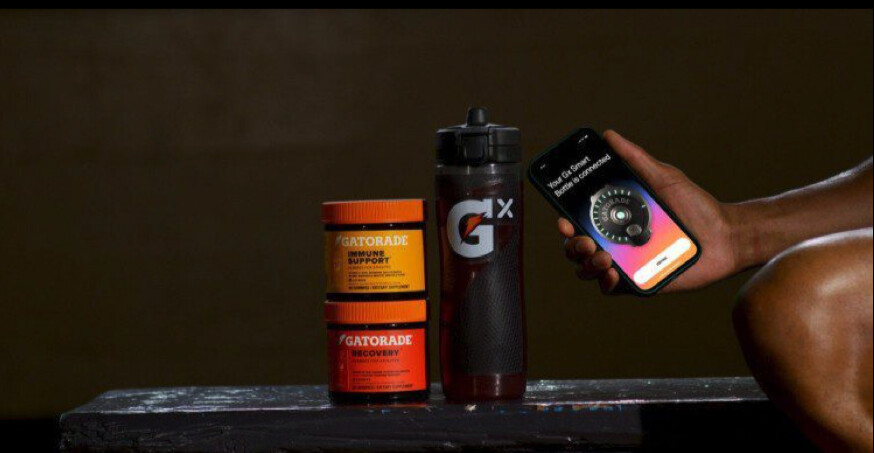
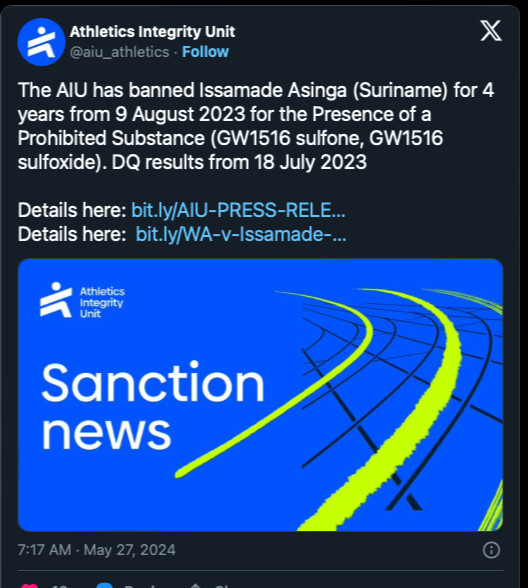
GW1516 was originally developed to treat obesity and diabetes, but is not approved for human use, due to its carcinogenic effects. It is banned both in and out of competition and is not eligible for a Therapeutic Use Exemption (TUE). A USADA bulletin from 2019 states that GW1516, also known as cardarine or endurobol, has been found in some supplements, despite being illegal.
Asinga claimed he took gummies from Gatorade that were supposed to help with recovery. He said two containers of the gummies revealed the presence of the banned substance, but the AIU panel stated he did not show proof that the gummies were the source of the drug found in his sample.
According to the AIU, Asinga claimed he took the Gatorade gummies the week before the positive test, and that subsequent testing of two unsealed containers of Gatorade gummies, provided by the athlete, revealed the presence of GW1516 and GW1516 sulfoxide. “The Disciplinary Tribunal found that Asinga did not satisfy his burden of proof to establish that the Gatorade Recovery Gummies were the source of the GW1516 metabolites detected in his sample.”
In making its decision, the AIU Disciplinary Tribunal stated that the Gatorade recovery gummies provided in unsealed containers by the athlete for testing contained significantly more GW1516 on the outside than on the inside, which practically excludes any contamination by raw ingredients during the manufacturing process. They also noted that the gummies were batch-tested by the National Sanitation Foundation (NSF), and that a sealed jar of the Gatorade recovery gummies, from the same batch taken by Asinga, tested negative for GW1516.
The 19-year-old sprinter plans to appeal the ban, which would take the case to the Court of Arbitration for Sport (CAS) in Switzerland.
All of Asinga’s results from July 18 onward will be disqualified, including his two South American Championships gold medals in the 100m and 200m, as well as his world U20 100m record of 9.89 seconds.
by Running Magazine
Login to leave a comment
100m world junior record holder suspended for doping
Suriname’s Issam Asinga, who only two weeks ago stunned the athletics world by shattering the U20 100m world record at the South American Championships in Sao Paulo, Brazil, has been provisionally suspended by the Athletics Integrity Unit (AIU) for the alleged use or presence of a prohibited substance . The suspension, which went into effect Wednesday and was announced by the AIU on Friday, is for the presence of GW1516, a substance that modifies how the body metabolizes fat, and which can boost endurance.
Provisional suspensions are issued before a hearing to determine whether the charges warrant any official punishment.
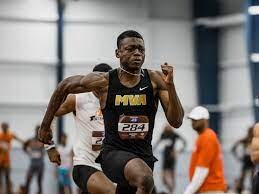
Botswana’s Nijel Amos, who won silver in the 800m at the 2012 Olympics in London, received a provisional suspension last year for the presence of the same metabolite ahead of the World Athletics Championships in Eugene, Ore. He ended up receiving a three-year ban.
GW1516 was originally developed to treat obesity and diabetes, but is not approved for human use, since it was discovered to be carcinogenic. It is banned in and out of competition, and not eligible for Therapeutic Use Exemption (TUE). A USADA bulletin from 2019 says GW1516 is also sometimes known as cardarine or endurobol and has been found in some supplements, even though it is illegal. In 2017, there were 31 sanctions worldwide related to its use.

The 18-year-old Asinga clocked an impressive 9.89 seconds with a tailwind of (-0.8m/s) on July 28 to become the first South American sprinter to break the 10-second barrier in the 100m. His blazing run surpassed the previous record of 9.91 seconds set by Botswana’s Letsile Tebogo at last year’s World U20 Championships in Cali, Colombia, and also broke the South American area record, bettering the 10.00 mark set by Brazil’s Robson da Silva in 1988.
In addition to claiming a world record in Brazil, Asinga’ also picked up a free PlayStation 5 with his performance. A tweet posted last week shows retired American sprinter Justin Gatlin handing Asinga the video game console with the caption “The special moment when Justin Gatlin promised Issam Asinga a PS5 if he ran a legal 9.8 and he delivered!”
Asinga has made headlines in the 2023 season, running for Montverde Academy near Orlando, Fla. Earlier this year, he beat world champion Noah Lyles in a 100m race to break the U.S. high school record, and a week later, broke Lyles’s 200m high school record in 19.97 seconds.
The provisional suspension appears to have dashed Asinga’s dreams for gold at the World Athletics Championships in Budapest later this month, where he was set to run the double. The sprinter has plans to head to Texas A&M University in the NCAA on a full track and field scholarship this fall.
by Running Magazine
Login to leave a comment
Another big blow! The Athletics Integrity Unit suspends Rodgers Kwemoi and Agnes Barsosio
The 2019 Hangzhou Marathon champion Agnes Barsosio and the 2022 N Kolay Istanbul Half Marathon Rodgers Kwemoi are the latest Kenyans to be summoned by the AIU.
The Athletics Integrity Unit has today, August 11 suspended other two Kenyans days after sanctioning Michael Kunyuga Njenga.
The 2019 Hangzhou Marathon champion Agnes Barsosio and the 2022 N Kolay Istanbul Half Marathon Rodgers Kwemoi are the latest Kenyans to be summoned by the AIU.
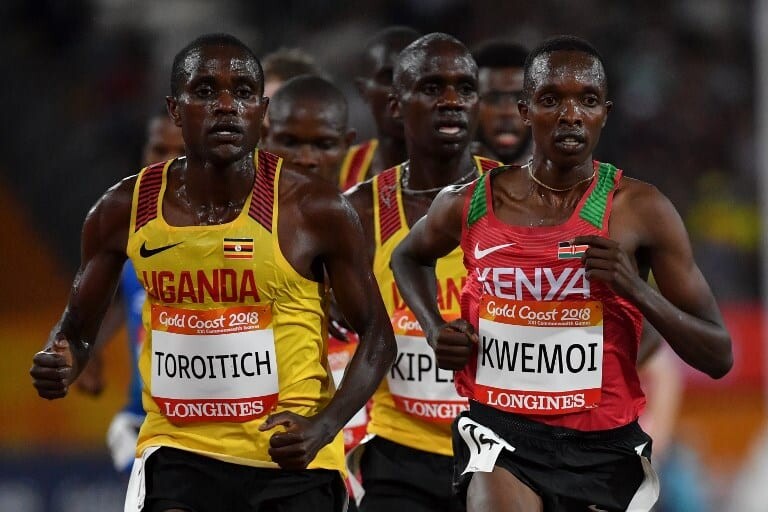
Barsosio has been suspended after testing positive for the use of a Prohibited Substance/Method – ABP. Barsosio has been inactive in athletics since her last race was during the 2021 Lisboa Marathon where she finished fourth.
In a tweet posted on their Twitter account, the AIU said: “The AIU has provisionally suspended Agness Jeruto Barsosio (Kenya) for the use of a Prohibited Substance/Method – ABP case.”
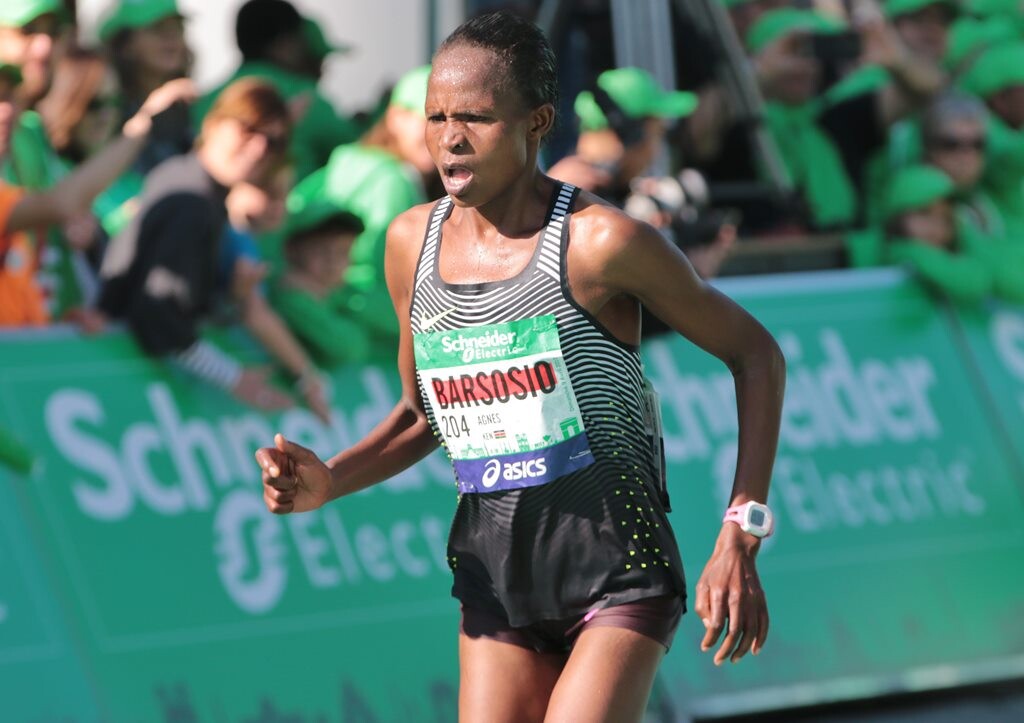
The same case applies to Kwemoi who has also been suspended for the use of ABP. Kwemoi has competed in a series of 10,000m races in Japan. He opened his season with a 10th place finish 31st at the Kanakuri Memorial Middle- and Long-Distance Invitational Meet.
He then proceeded to the 1st Nittaidai Challenge Games and 67th Central Japan Corporate Teams Athletics Championships where he finished ninth and third respectively.
The AIU has also suspended the latest kid on the block, Surinam’s Issam Asinga for the use of Prohibited Substance (GW1516). The 18-year-old has made headlines this year after breaking the Under-20 100m world record at the South American Championships.
The sanction means the trio is suspended temporarily from participating in any competition or activity in Athletics prior to a final decision at a hearing conducted under the World Athletics Anti-Doping Rules or the Integrity Code of Conduct.
by Abigael Wafula
Login to leave a comment
18-year-old sprinter Issam Asinga breaks world junior 100m record
In a remarkable debut on the international stage, 18-year-old Issam Asinga of Suriname stunned the athletics world on Friday, shattering the U20 100m world record at the South American Championships in Sao Paulo, Brazil. Asinga clocked an impressive 9.89 seconds with a tailwind of (-0.8m/s) to become the first South American sprinter to break the 10-second barrier in the 100m.
Asinga’s blazing run surpassed the previous record of 9.91 seconds set by Botswana’s Letsile Tebogo at last year’s World U20 Championships in Cali, Colombia, and also broke the South American area record, bettering the 10.00 mark set by Brazil’s Robson da Silva in 1988.
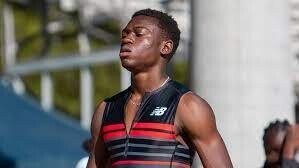
To make his record more impressive, his time was run at altitude, as Sao Paulo sits nearly 800m above sea level. Asinga’s new record also sparred other fast times in the field, with Brazil’s Erik Cardoso breaking the Brazilian national record for silver in 9.97.
The 18-year-old sprint phenom has made headlines in the 2023 season, running for Montverde Academy near Orlando, Fla. Earlier this year, he beat world champion Noah Lyles in a 100m race to break the U.S. high school record, and a week later, broke Lyles’s 200m high school record in 19.97 seconds.
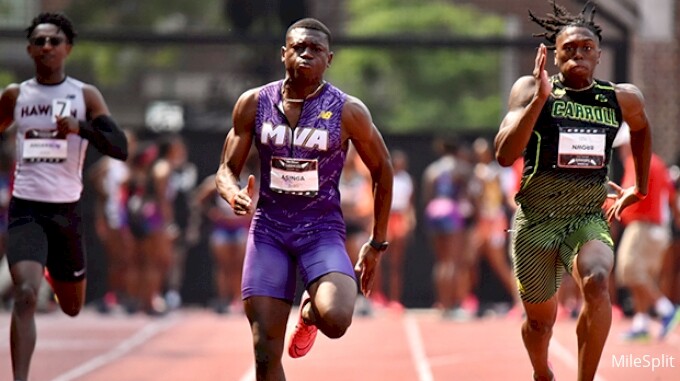
Asinga’s sights are now on the 2023 World Athletics Championships in Budapest this August, where he will run the sprint double. After worlds, Asinga will head to Texas A&M University in the NCAA on a full track and field scholarship. His exceptional talent runs in the family. His father, Tommy Asinga, holds multiple national records for Suriname and represented the country at three Olympic Games (1988, 1992 and 1996).
by Marley Dickinson
Login to leave a comment
High school sprinter beats world champion Noah Lyles in 100m race
American high schooler Issam Asinga ran an incredible 9.83-second 100m race on Sunday, winning the race and beating 200m world champion and Olympic bronze medalist Noah Lyles in the process. The 18-year-old Asinga’s time is the fastest ever recorded by an American high school athlete under any conditions, although it was wind-aided at 2.6 meters per second (the limit for wind is 2.0 meters per second). Wind-legal or not, Asinga’s run was phenomenal, and he is certainly someone to follow in the coming years.
Sunday’s run was not Asinga’s first time storming into the record books. In March at the New Balance Nationals Indoor meet, he tied the American high school 60m record with a 6.59-second run, and broke the national high school 200m record in 20.48 seconds. His 100m result in Florida is undoubtedly his most impressive feat yet, as he took down Lyles to do it.

The official American high school boys record stands at 10 seconds flat—a time Trentavis Friday ran in 2014. That is as close as any high schooler has come to breaking 10 seconds in legal conditions. Before Asinga’s run on Sunday, Matt Boling had the fastest all-conditions run in American high school history, posting a 9.98-second 100m back in 2019. That race saw winds of 4.2 meters per second.
Despite running in far slower winds than Boling felt during his race, Asinga obliterated that record, flying to the finish line. A wind conversion calculator shows that his result is equal to a 9.85 run in 2.0m/s wind and a 9.93 in still conditions. In either case, Asinga’s time would smash all previous American high school records.

After the race, Lyles took to Twitter to congratulate the young sprinter. “Shout out to Issam Asinga,” he wrote. “I can definitely see us racing on the big stages if you keep improving and you can definitely get that HS record man!” There’s no word on when Asinga’s next race will come, but it will be an exciting one to watch as he chases a wind-legal result.
by Running Magazine
Login to leave a comment


